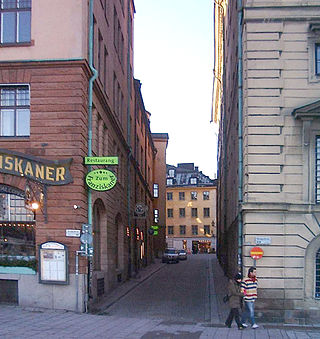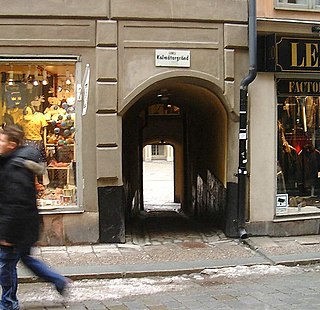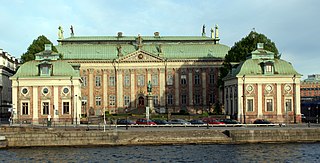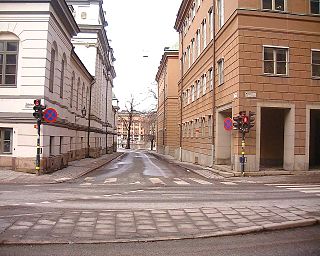

Brantingtorget (Swedish: "Square of Branting") is the courtyard of the Chancery House annex (Kanslihusannexet), serving as one of the public squares in Gamla stan, the old town in central Stockholm, Sweden. [1]


Brantingtorget (Swedish: "Square of Branting") is the courtyard of the Chancery House annex (Kanslihusannexet), serving as one of the public squares in Gamla stan, the old town in central Stockholm, Sweden. [1]
The square is named after the country's first democratically elected Prime Minister, Hjalmar Branting (1860–1925). It was designed along with the surrounding buildings by the architect Artur von Schmalensee (1900–1972) and built between 1945 and 1950. [2]
It is connected to the surrounding streets by several passages, of which some of which are remnants of alleys once criss-crossing the block – Klockgjutargränd, Kolmätargränd, and Stenbastugränd. The dramatic contrast between the narrow alleys and the relatively large open space they conceal, is astonishingly harmonic, the result of a compromise between the will of antiquaries wanting to preserve the medieval architecture and that of the department wanting to displace what they considered a slum in disrepair. The post-WW2 classicism of the place excited a mode of indignation among other contemporary architects, claiming modern democracy had dressed itself up in a disguise. [3] [4]
Centred on the square is the bronze sculpture Morgon from 1962 by Ivar Johnsson (1885-1970). [5]

Gamla stan, until 1980 officially Staden mellan broarna, is the old town of Stockholm, Sweden. Gamla stan consists primarily of the island Stadsholmen. Officially, but not colloquially, Gamla stan includes the surrounding islets Riddarholmen, Helgeandsholmen and Strömsborg. It has a population of approximately 3,000.

The Bonde Palace is a palace in Gamla stan, the old town in central Stockholm, Sweden. Located between the House of Knights (Riddarhuset) and the Chancellery House (Kanslihuset), it is, arguably, the most prominent monument of the era of the Swedish Empire (1611–1718), originally designed by Nicodemus Tessin the Elder and Jean De la Vallée in 1662-1667 as the private residence of the Lord High Treasurer Gustaf Bonde (1620–1667) it still bears his name, while it accommodated the Stockholm Court House from the 18th century and since 1949 houses the Swedish Supreme Court. On the south side of the building is the street Myntgatan and the square Riddarhustorget, while the alleys Riddarhusgränd and Rådhusgränd are passing on its western and eastern sides.

Gustav Adolfs torg is a public square in central Stockholm, Sweden.

Stortorget is a public square in Gamla Stan, the old town in central Stockholm, Sweden. It is the oldest square in Stockholm, the historical centre on which the medieval urban conglomeration gradually came into being. Today, the square is frequented by tens of thousands of tourists annually, and is occasionally the scene for demonstrations and performances. It is traditionally renowned for its annual Christmas market offering traditional handicrafts and food.

Birger Jarls torg is a public square on Riddarholmen in Gamla stan, the old town in Stockholm, Sweden.

Västertorp (Westcroft) is a district of the Hägersten-Liljeholmen borough in Söderort, the southern suburban part of Stockholm, Sweden.

Järntorget is a small public square in Gamla stan, the old town in central Stockholm, Sweden. Located in the southernmost corner of the old town, the square connects the thoroughfares Västerlånggatan and Österlånggatan, while the two alleys, Södra Bankogränd and Norra Bankogränd, stretches east to connect the square to Skeppsbron, and two other alleys, Järntorgsgatan and Triewaldsgränd, leads south to Slussplan and Kornhamnstorg respectively.

Västerlånggatan is a street in Gamla stan, the old town of Stockholm, Sweden. Stretching southward between the squares Mynttorget and Järntorget, it follows the course of the city's now demolished 13th-century defensive wall.

Österlånggatan is a street in Gamla stan, the old town of Stockholm, Sweden. Stretching southward from Slottsbacken to Järntorget, it forms a parallel street to Baggensgatan and Skeppsbron. Major sights include the statue of Saint George and the Dragon on Köpmanbrinken and the restaurant Den Gyldene Freden on number 51, established in 1722 and mentioned in Guinness Book of Records as one of the oldest with an unaltered interior.

Telegrafgränd is an alley in Gamla stan, the old town of Stockholm, Sweden. Stretching from Skeppsbron to Österlånggatan, it is a parallel street to Slottsbacken and Skeppar Karls Gränd.

Södra Bankogränd is an alley in Gamla stan, the old town of Stockholm, Sweden. Connecting Skeppsbron to Österlånggatan and Järntorget, it forms a parallel street to Norra Bankogränd and Norra Dryckesgränd.

Tyska Brunnsplan is a small, triangular public square in Gamla stan, the old town in central Stockholm, Sweden. It is located in the junction between the streets Svartmangatan and Själagårdsgatan, the former leading to Stortorget and the latter to Brända Tomten. As several local names knows to tell the square is named after the vicinity to the German Church and the German community which once occupied the neighbourhood.

Slottsbacken is a street in Gamla stan, the old town in central Stockholm, Sweden.

Högvaktsterrassen is a street in Gamla stan, the old town in central Stockholm, Sweden passing west of Yttre Borgården, the outer court of the Stockholm Palace.

Kolmätargränd is a small alley in Gamla stan, the old town in central Stockholm, Sweden. Passing under a low vault it connects the street Västerlånggatan to the square and courtyard Brantingtorget forming a parallel street to Klockgjutargränd and Stenbastugränd.

Riddarhuskajen is a quay in Gamla stan, the old town in central Stockholm, Sweden. Located north of both the square Riddarhustorget and the House of Knights, it stretches east from the north-western corner of the island Stadsholmen to the bridge Vasabron and the alley Riddarhusgränd. Just west of the quay passes the motorway Centralbron, while the quay Kanslikajen forms an eastward extension leading past Kanslihuset to Stallbron and Mynttorget.

Rådhusgränd is an alley in Gamla stan, the old town in central Stockholm, Sweden. Stretching from the junction between the street Myntgatan and the square Riddarhustorget, and passing between the Bonde Palace and Kanslihuset, it leads north to the bridge Vasabron, while forming a parallel street to Riddarhusgränd. Along the waterfront north of the alley passes the quay Kanslikajen.

Tyska Stallplan is a street in Gamla stan, the old town in central Stockholm, Sweden. Stretching south from Svartmangatan to Prästgatan, it is connected to Baggensgatan and Mårten Trotzigs Gränd, while forming a (somewhat) parallel street to Österlånggatan and Tyska Brinken.

The Matchstick Palace is an office building on Västra Trädgårdsgatan in Stockholm, Sweden.

The Saint Nicholas Church or the Nicholas Church is a church building in central Örebro, Sweden. It was originally called the Örebro Church because it was the only Church of Sweden building in town until the early 20th century. Örebro Nikolai parish is in the Diocese of Strängnäs of the Church of Sweden.
59°19′33.7″N18°04′5.1″E / 59.326028°N 18.068083°E